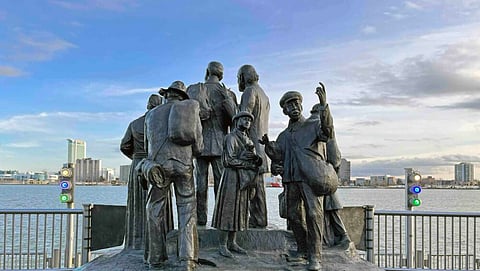

"Follow the drinkin' gourd," they sang, as the north star pointed toward freedom.
It's dark. We're seated in a pew at the First Congregational Church of Detroit. A storyteller appears. We rise and follow him to the stairwell. Silent. Single file. He leads us down to the basement and along the the Underground Railroad that operated between 1840 and 1863. This is a living museum. Our journey begins at Oak Alley plantation in Louisiana.
Time was, safe houses along the way, secret markers sewn into quilts, and codes embedded in the lyrics of folk songs provided a road map for fugitive slaves to reach Detroit, the Gateway to Freedom, cross the river and find safe harbour in Canada. Neither underground nor a railroad, it was a complicated network of good Samaritans operating on faith and chance.
My son is gripping my hand tightly. Our guide, immersed in his role, warns us of traps, and that many of us will be caught. A pair of boots set on a bench by a farm in Mississippi lets us know it's safe to continue. The topography is changing as we head northwards. At our encampment in Tennessee, the oldest in our group is instructed to sacrifice herself, and distract those on our trail, so that the rest of us can keep going, tiptoeing to a forest in Kentucky under the cloak of night. Suddenly we jump back! Another freedom-seeker darts out of the woods, scaring us out of our wits, and begging to join our group. Eventually, our guide's cynicism proves wise when the interloper betrays us to save himself. Hurriedly, we shelter in a shed at an Amish farm somewhere in Ohio. After a prayer, we sneak out to the path. Strategically placed lanterns signal us onward. Finally arriving at the shore of the Detroit River, it's now a matter of pushing off on a raft and braving the midnight current to the cries of freedom.
As far as living museums go, this Underground Railroad Tour is disarmingly, yet appropriately, effective. We're provided a visceral conveyance into what we've only read about. And for my son, this kind of simulated-exposure to a chapter in history is a leap off the page into his consciousness, and enabling sensitivity toward parallel plights in the news today.
Spanning geography and time, the Charles H. Wright Museum of African American History's And Still We Rise exhibit is also a powerful experience that leads us on a journey through over twenty galleries. From the roots of inter-tribal slavery in Africa, co-opted by European mercantilism and exported across the Americas, slavery emerged as a burgeoning industry. Curated chronologically, we navigate these archives of inhumanity punctuated by the heroism of African-American resilience. Comprehensive without reservation, this is the largest permanent collection of African-American culture in the world.
We explore the rich cultural legacy that emerged from the Great Migration of African Americans from the south to Detroit, which was both in response to and helped fuel Detroit's automotive industry boom. With it came the southern oral and musical traditions of blues, jazz and gospel. Just as the conductors along the Underground Railroad used songs to guide and lift spirits, so too did the power of song become integral to the civil rights movement.
Profiles and stories connect the dots, like that of the musical preaching of a southern Baptist minister, C. L. Franklin, or the soul singing of his daughter, Aretha. Streams of history converge into the cultural milieu—from African to African American. This is American history. It is charted through an accessible perspective that provides context and insight to deepen and broaden our understanding of the background and present dynamics of complicated issues.
The monuments that distinguish Detroit's special place in history do not just memorialize the past, they are the ingredients of the artists and the activists that inspire the current social and political movements, thriving independent art scenes, great music, soulful cuisine and palpable energy that is driving this great American city's resurgence into the future.